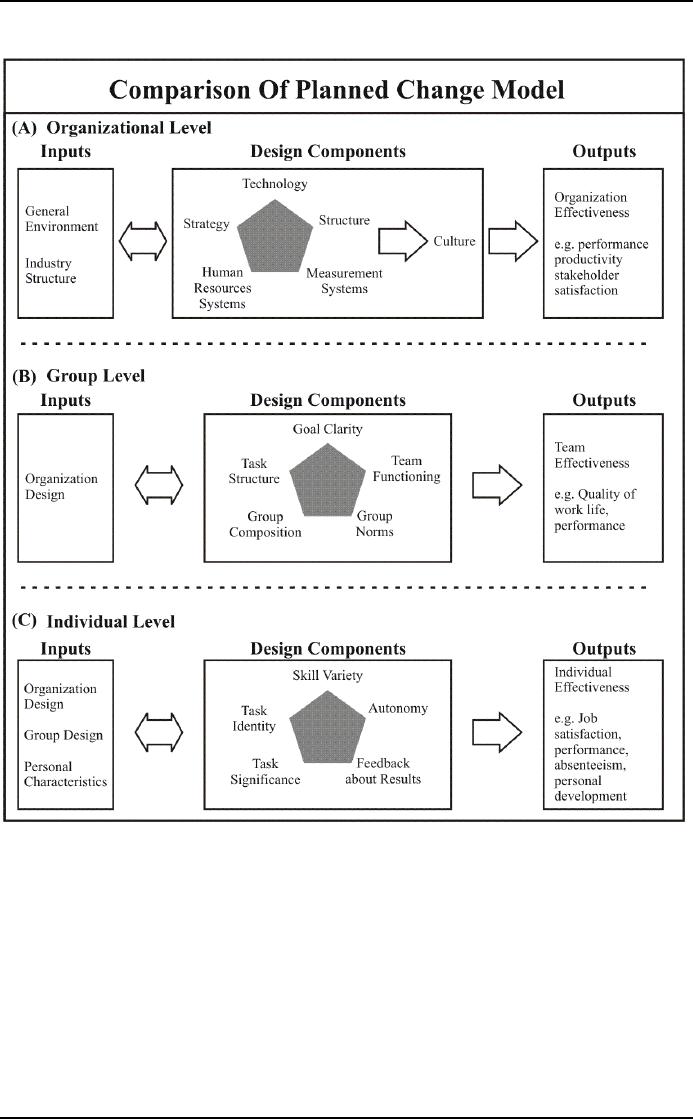 |

Organization
Development MGMT
628
VU
Lesson
19
Diagnosing
Groups and Jobs
Figure
25: Comprehensive Model for
Diagnosing Organizational
Systems
Individual-Level
Diagnosis:
The
lowest level of organizational diagnosis is the
individual job or position. An
organization consists of
numerous
groups; a group, in turn, is composed of
several individual jobs. This
section discusses the
inputs,
design components, and relational
fits for diagnosing jobs.
The model shown in Figure 25(C)
is
similar
to other popular job
diagnostic frameworks, such as
Hackrnan and Oldhamn's job
diagnostic survey
and
Herzberg's job enrichment model.
Inputs:
Three
major inputs affect job design:
organization design, group design,
and the personal characteristics
of
job
holders.
Organization
design is concerned with the
larger organization within which the
individual job is the
smallest
unit. Organization design is a key
part of the larger context surrounding
jobs. Technology,
structure,
measurement systems, human
resources systems, and culture
can have a powerful impact
on the
way
jobs are designed and on
people's experiences in jobs.
For example, company reward
systems can

Organization
Development MGMT
628
VU
orient
employees to particular job behaviors
and influence whether people see job
performance as fairly
rewarded.
In general, technology characterized by relatively
uncertain tasks and low
interdependency is
likely
to support job designs allowing
employees flexibility and discretion in
performing tasks.
Conversely,
low-uncertainty
work systems are likely to
promote standardized job
designs requiring routinized
task
behaviors.
Group
design concerns the larger
group or department containing the
individual job. Like
organization
design,
group design is an essential
part of the job context. Group
task structure, goal
clarity, composition,
performance
norms, and group functioning
serve as inputs to job design. They
typically have a more
immediate
impact on jobs than do the larger,
organization-design components. For
example, group task
structure
can determine how individual
jobs are grouped together -- as in groups
requiring coordination
among
jobs or in ones comprising collections of independent
jobs. Group composition can
influence the
kinds
of people who are available to
fill jobs. Group performance
norms can affect the kinds of job
designs
that
are considered acceptable,
including the level of job holders'
performances. Goal clarity helps
members
to
prioritize work, and group
functioning can affect how
powerfully the group influences
job behaviors.
When
members maintain close relationships and
the group is cohesive, group
norms are more likely to
be
enforced
and followed.
Personal
characteristics of individuals occupying
jobs include their age, education,
experience, and skills
and
abilities.
All of these can affect job
performance as well as how people
react to job designs.
Individual
needs
and expectations can also
affect employee job responses.
For example, individual
differences in
growth
need -- the need for self-direction,
learning, and personal accomplishment --
can determine how
much
people are motivated and
satisfied by jobs with high
levels of skill variety,
autonomy, and
feedback
about
results. Similarly, work motivation
can be influenced by people's
expectations that they can
perform
a
job well and that
good job performance will
result in valued
outcomes.
Design
Components:
Figure
25(C) shows that individual
jobs have five key
dimensions: skill variety,
task identity, task
significance,
autonomy, and feedback about
results.
Skill
variety identifies the degree to which a
job requires a range of
activities and abilities to perform
the
work.
Assembly-line jobs, for example,
generally have limited skill
variety because employees perform
a
small
number of repetitive activities. Most
professional jobs, on the other
hand, include a great deal of
skill
variety
because people engage in diverse
activities and employ several different
skills in performing
their
work.
Task
identity measures the degree to
which a job requires the
completion of a relatively whole,
identifiable
piece
of work. Skilled craftspeople, such as
tool-and-die makers and
carpenters, generally have
jobs with
high
levels of task identity. They
are able to see a job
through from beginning to end.
Assembly-line jobs
involve
only
a
limited
piece
of
work
and
score
low
on
task
identity.
Task
significance identifies the degree to
which a job has a significant
impact on other people's
lives.
Custodial
jobs in a hospital are likely to
have more task significance
than similar jobs in a toy
factory
because
hospital custodians are likely to
see their jobs as affecting
someone else's health and
welfare.
Autonomy
indicates the degree to which a
job provides freedom and discretion in
scheduling the work
and
determining
work methods. Assembly-line jobs
generally have little autonomy: the
work pace is
scheduled,
and
people perform programmed tasks.
College teaching positions have
more autonomy: professors
usually
can
determine how a course is taught,
even though they may have
limited say over class
scheduling.
Feedback
about results involves the degree to
which a job provides employees
with direct and clear
information
about the effectiveness of task
performance. Assembly-line jobs often
provide high levels
of
feedback
about results, whereas college
professors must often contend
with indirect and
ambiguous
feedback
about how they are performing in the
classroom.
Those
five job dimensions can be
combined into an overall measure of
job enrichment. Enriched jobs
have
high
levels of skill variety,
task identity, task
significance, autonomy, and
feedback about results.
They
provide
opportunities for self
direction, learning, and personal
accomplishment at work. Many people
find
enriched
jobs internally motivating
and satisfying.
Fits:
The
diagnostic model in Figure 25(C) suggests
that job design must
fit job inputs to produce effective
job
outputs,
such as high quality and
quantity of individual performance,
low absenteeism, and high
job
satisfaction.
Research reveals the following
fits between job inputs and
job design:
1.
Job
design should be congruent with the
larger organization and group
designs within which
the
job
is embedded. Both the organization and
the group serve as a powerful
context for individual jobs
or
positions.
They tend to support and
reinforce particular job
designs.
Highly differentiated
and

Organization
Development MGMT
628
VU
integrated
organizations and groups
that permit members to
self-regulate their behavior
fit enriched jobs.
These
larger organizations and
groups promote autonomy,
flexibility, and innovation at the
individual
job
level. Conversely, bureaucratic
organizations and groups
relying on external controls are congruent
with
job
designs scoring low on the
five key dimensions. Both
organizations and groups reinforce
standardized,
routine
jobs. As suggested earlier, congruence
across different levels of organization
design promotes
integration
of the organization, group, and job
levels. Whenever the levels do
not fit each other,
conflict is
likely
to emerge.
2.
Job
design should fit the personal
characteristics of the jobholders if they are to
perform
effectively
and derive satisfaction from
work. Generally, enriched
jobs fit people with
strong
growth needs. These people derive
satisfaction and accomplishment
from
performing
jobs
involving skill variety,
autonomy, and feedback about
results. Enriched jobs also
fit
people
possessing moderate to high
levels of task-relevant skills,
abilities, and knowledge.
Enriched
jobs generally require complex
information processing and
decision making;
people
must have comparable skills
and abilities to perform effectively.
Jobs scoring low on
the
five
job dimensions generally fit
people with rudimentary skills and
abilities and with low
growth
needs.
Simpler, more routinized jobs requiring
limited skills and
experience fit better with
people
who
place a low value on
opportunities for self-
direction and learning. In
addition, because
people
can grow through education,
training, and experience,
job design must he monitored
and
adjusted
from time to time.
Table of Contents:
- The Challenge for Organizations:The Growth and Relevance of OD
- OD: A Unique Change Strategy:OD consultants utilize a behavioral science base
- What an “ideal” effective, healthy organization would look like?:
- The Evolution of OD:Laboratory Training, Likert Scale, Scoring and analysis,
- The Evolution of OD:Participative Management, Quality of Work Life, Strategic Change
- The Organization Culture:Adjustment to Cultural Norms, Psychological Contracts
- The Nature of Planned Change:Lewin’s Change Model, Case Example: British Airways
- Action Research Model:Termination of the OD Effort, Phases not Steps
- General Model of Planned Change:Entering and Contracting, Magnitude of Change
- The Organization Development Practitioner:External and Internal Practitioners
- Creating a Climate for Change:The Stabilizer Style, The Analyzer Style
- OD Practitioner Skills and Activities:Consultant’s Abilities, Marginality
- Professional Values:Professional Ethics, Ethical Dilemmas, Technical Ineptness
- Entering and Contracting:Clarifying the Organizational Issue, Selecting an OD Practitioner
- Diagnosing Organizations:The Process, The Performance Gap, The Interview Data
- Organization as Open Systems:Equifinality, Diagnosing Organizational Systems
- Diagnosing Organizations:Outputs, Alignment, Analysis
- Diagnosing Groups and Jobs:Design Components, Outputs
- Diagnosing Groups and Jobs:Design Components, Fits
- Collecting and Analyzing Diagnostic information:Methods for Collecting Data, Observations
- Collecting and Analyzing Diagnostic information:Sampling, The Analysis of Data
- Designing Interventions:Readiness for Change, Techno-structural Interventions
- Leading and Managing Change:Motivating Change, The Life Cycle of Resistance to Change
- Leading and managing change:Describing the Core Ideology, Commitment Planning
- Evaluating and Institutionalizing Organization Development Interventions:Measurement
- Evaluating and Institutionalizing Organization Development Interventions:Research Design
- Evaluating and Institutionalizing Organization Development Interventions
- Interpersonal and Group Process Approaches:Group Process
- Interpersonal and Group Process Approaches:Leadership and Authority, Group Interventions
- Interpersonal and Group Process Approaches:Third-Party Interventions
- Interpersonal and Group Process Approaches:Team Building, Team Building Process
- Interpersonal and Group Process Approaches:Team Management Styles
- Organization Process Approaches:Application Stages, Microcosm Groups
- Restructuring Organizations:Structural Design, Process-Based Structures
- Restructuring Organizations:Downsizing, Application Stages, Reengineering
- Employee Involvement:Parallel Structures, Multiple-level committees
- Employee Involvement:Quality Circles, Total Quality Management
- Work Design:The Engineering Approach, Individual Differences, Vertical Loading
- Performance Management:Goal Setting, Management by Objectives, Criticism of MBO
- Developing and Assisting Members:Career Stages, Career Planning, Job Pathing
- Developing and Assisting Members:Culture and Values, Employee Assistance Programs
- Organization and Environment Relationships:Environmental Dimensions, Administrative Responses
- Organization Transformation:Sharing the Vision, Three kinds of Interventions
- The Behavioral Approach:The Deep Assumptions Approach
- Seven Practices of Successful Organizations:Training, Sharing Information